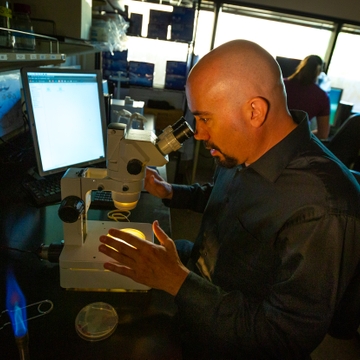Preparing for Disaster: UNM Hospital Participates in Region-Wide Emergency Training

Who Wants to Live Forever?
Mark McCormick Searches for the Key to Longevity in Yeast and Tiny Roundworms
"I've got one that's 54 days old!" exclaims Christine Robbins. With a touch of whimsy, she adds, "I think I'm going to name this one Cleopatra."
Robbins, who manages Mark McCormick's laboratory in UNM's Biomedical Research Facility, is talking about an unusual example of Caenorhabditis elegans - a tiny roundworm known as a nematode. The typical nematode lives for only 14 to 21 days.
"Sometimes we name the ones that live the longest," observes McCormick, an assistant professor in the Department of Biochemistry & Molecular Biology. "We get kind of attached."
McCormick's research focuses on the molecular mechanisms of healthy aging. Surrounded by stacks of petri dishes, his graduate students spend their time intently staring into microscopes and rapidly entering numbers onto large spreadsheets open on computer screens in front of them. They are measuring how long the nematodes remain active.
Genes, which are like our body's blueprints, are found in every cell. They can define every aspect of our existence, from building our bones, creating our muscles and maintaining our health to predisposing us to disease and influencing how we age. McCormick's lab studies the genes that affect the replicative lifespan in yeast and healthy aging in nematodes by using single genetic "knockout" models.
In these models, one gene at a time is deleted, then the longevity of the offspring is measured. McCormick has collected thousands of these different models. By using these single knockout models and measuring how short or how long these tiny organisms live he hopes to identify genes that can be targeted with therapies to extend life.
In fact, McCormick has already identified some new ways to extend lifespan, through multiple biological pathways in yeast and nematodes that are surprisingly similar in humans - hence Robbins' excitement about Cleopatra's longevity.
By first understanding this process of extending life in smaller, less complex species, McCormick hopes that his lab can one day translate their work to much more complex organisms, like mice and human beings. His team uses machine learning, computer coding and complex pathway analyses to assess these large, complex data sets of multiple single genetic knockouts.
Testing in these small critters allows his lab the ability to study lifespan in a much shorter time frame rather than in more complex animals like mice, which can live two years, or macaque monkeys, which can live up to 27 years.
McCormick, who came to UNM in 2017, is a mentored principal investigator through UNM's Autophagy Inflammation and Metabolism Center of Biomedical Research Excellence, an international powerhouse of scientists and state-of-the-art equipment.
McCormick and his team next hope to explore their findings in mammalian cells to see whether they show the same sorts of genetic changes associated with extended lifespan.
"We're reverse-engineering an incredibly complicated machine," McCormick says. "It's painstaking, but it's a very powerful approach."